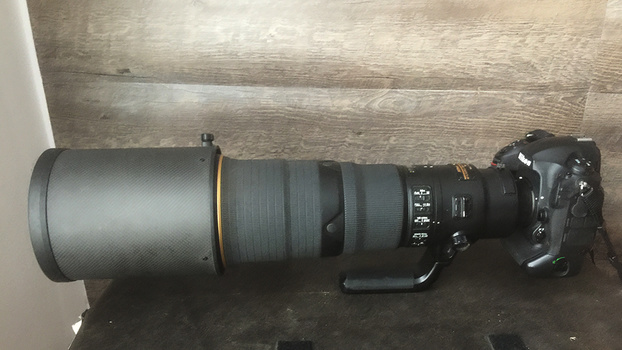Today, I’d like to discuss one of the most overused and most misunderstood concepts in photography. What exactly makes something a “professional camera”?
If you’ve spent any amount of time reading or watching camera reviews (and let’s be honest, who among us hasn’t), then it’s highly likely that you’ve heard the terms “pro body” or “professional gear” thrown around. Usually, the reviewer is using this term as a sort of shorthand to denote what sets this particular camera apart from the other ones in the same brand’s lens lineup. For instance, why does a Nikon D6 cost around $6,500 whereas a Z 6II only cost around $2,000? As a shorthand, some might say that the D6 is a “pro-level body,” whereas the Z 6II is not.
But, setting aside for a moment whether or not I actually agree with that statement, it’s also a bit misleading because it gives the impression that, in order to be professional, you need to be shooting with a “professional” camera body. It makes sense why reviewers use this as shorthand. There are features that high-end cameras have that would appeal to pros but not make much of a difference to most hobbyists. And, like most things in life, you do tend to get what you pay for, so even a $6,500 can earn its price tag for the right customer. But, I think the more pertinent question that first has to be answered is, who is a professional photographer?
Since aesthetics are highly subjective, trying to call someone a pro or not based on talent is somewhat of a fool’s errand. After all, lots of people are amazing photographers without being pro photographers because they choose instead to make their living as dentists, or lawyers, or factory workers. Simply having a “pro body” can’t qualify you as a professional. Otherwise, all you would have to do to become a professional photographer would be to save up enough cash to buy an expensive camera. That may impress your photo friends, but I think we can all agree that you need to accomplish a bit more than being good at spending money to be a professional photographer.
Personally, I choose to go by the one unavoidable judge and jury, the IRS. For tax purposes, you are generally judged to be a professional in a given field if you make over 50% of your income from providing those services. The numbers may vary depending on your principality, but the basic equation, in my opinion, for being a professional photographer is whether or not you are able to establish a photography business upon which you can make a living. There is obviously some wiggle room in that equation as everyone’s situation is different, but I’ll use that as a baseline for our discussion, because I think it’s an important thing to consider when discussing whether or not a camera you are considering purchasing is “pro” level or not.

I’ll give you an example. When I was first starting out, the only camera I could afford was a Nikon D200. Though not too shabby at the time it was released, the 10.2 MP it provided would hardly be considered a “pro-level” photography body. Yet, it is the camera I used to start my business and generate an income.
Likewise, many wedding photographers shoot with cameras as the Z 6II mentioned in my earlier comparison. They need multiple bodies at an affordable price point that can do a lot of different things on a wedding day. But they don’t necessarily need to be able to shoot at the same ridiculously high frame rates that might be an absolute necessity to another photographer who might, for example, be tasked with capturing images of an NFL game and thus genuinely need a camera like the D6. So, both photographers are making the right choice for their subject matter and section of the profession. But, would you say that the wedding photographer who shoots multiple weddings each week isn’t a professional photographer because they aren’t carrying a “pro” body? Of course not.
This discussion may sound ridiculous. Partly because it is. But I do still remember those days early on when photography was still more of a hobby than a legitimate avenue to pay my mortgage. At that point, when you are still not exactly clear on how those professional photographers that you admire actually make their money or get their assignments, it’s tempting to say things to yourself like: “Well, if only I had a more expensive camera, then I could shoot images like that.” Or you might even offer yourself the greater delusion that clients actually hire photographers based on the gear they own rather than based on their creativity, complete suite of skills they bring to the table, and ability to help their clients reach their own objectives.
The simple fact of the matter is that your level of professionalism and your value as a photographer are not defined by the camera in your bag. It’s defined by the artistic vision that you bring to the process and the solutions you can provide.

Of course, as I said earlier, there are definitely differences between cameras at different price points. The more relevant question to ask yourself, however, is whether or not those prices apply to you. As a case in point, I recently borrowed a Nikon D5 and a 500mm f/4 E FL ED VR lens from Nikon Professional Services. While I’ve been, by legal standards, a professional photographer for going on two decades now, I have never owned one of the “pro body” style Nikon bodies like the D4, D5, or D6 with the built-in grip. My work is in commercial advertising, so those cameras never had the resolution I needed for the majority of my jobs. And their biggest selling point, the ability to shoot at ridiculously high frame rates, was not something that I really ever required for my job. So, there was never really any reason for me to buy one since models like the D850 or medium format systems have always been better suited to my needs.
But, of course, that doesn’t mean that I wasn’t curious. What was all the hype about? Was it really worth that price tag? When Nikon recently announced that they were in the development of a Z 9 flagship mirrorless camera that would borrow from the D6 body type with the built-in vertical grip and be similarly built for speed, I wanted to see for myself what it was like to shoot with a bigger body.
Of course, the immediate answer to that question was heavy. Very heavy. It was incredibly heavy carrying around the D5 and 500mm f/4 combination. Of course, it’s supposed to be. That’s not the type of thing people purchase with an intention of walking around doing street photography. It’s really a combination more geared towards sideline sports shooters or wildlife photographers who will be mounting the combination to the top of a tripod. I had chosen to get the combo on loan because, on the weekends, I enjoy doing a little bird photography. I am decidedly not a professional wildlife photographer, mind you. So, I make no claims as to be any good at it. But I enjoy it as a stress relief from my actual photography work, so I figured I would treat myself to some high-level equipment for a weekend out to have a little fun.
Speaking of fun, I realize that I lead with a serious discussion of how one chooses a pro body based on their own needs as a professional, but I will say that shooting with the D5 was insanely fun. Though I don’t need all those frames per second for my professional work, I couldn’t help but smile at the sound of the camera rattling off frames at the speed of a machine gun without breaking a sweat. I’m fairly certain that a great many of the shots I took with the D5 were simply taken so that I could hear that loud and rather satisfyingly thunderous clap of the D5 shutter when you take a picture. I know all the logical reasons why someone would want to use a silent shutter. But there is just something about the ratta-tat-tat of the D5 that makes you feel alive when shooting with it.

The build quality of the “pro body” is also immediately apparent. A lot of cameras claim to be weather resistant. But the apparent and redundant weather sealing all around the D5 was enough to convince me that you really could work with it under almost any weather conditions without having the slightest of concerns that it wouldn’t be able to handle the elements.
The body itself is built like a brick, which I say in the most complimentary way possible. Let’s just say that if someone broke into your house and all you had to defend yourself was a baseball bat and this camera, I think you’d have pretty good odds at being able to knock out the intruder with either one. The advantage of using the D5 would be that you could continue to rattle off a multitude of uninterrupted frames during the process.
A “pro-level” camera also comes with all the bells and whistles specific to the tasks required by those who shoot with it. Things like built-in LAN connections which enable news photographers to quickly upload images to the newsroom or other end users are the type of thing that an architectural photographer, for example, would have no need for. But for people who do need this type of feature, this level of camera is covered in such functional considerations.
In short, a “pro body” does and should provide the features that are necessary for its end users to perform their job at the highest level through both foreseen and unforeseen circumstances. It’s the kind of camera you take with you into a war zone when you know you’re not going to have a lot of chances to get “the” shot and you need your gear to keep working flawlessly no matter what.
Now, do you need that level of camera for what you like to shoot? Well, that’s a question only you can answer. What is easy to proclaim however is that what defines a professional photographer is not that they are using what a marketing department has declared a “professional camera,” but rather he or she’s the ability to generate work at a professional level and generate business putting those skills to use. So, the real definition of a “professional camera” is not defined by price tags or preset specifications, but rather whether or not it has the features you need to provide your clients with the assets they need and can help you generate the income to sustain yourself and your career.